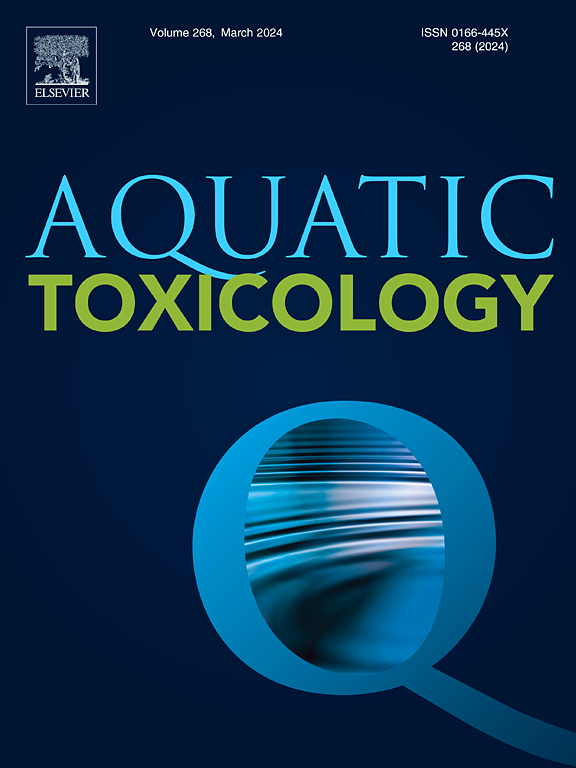Polystyrene microplastics exacerbate acetochlor-induced reproductive toxicity and transgenerational effects in zebrafish
IF 4.1
2区 环境科学与生态学
Q1 MARINE & FRESHWATER BIOLOGY
引用次数: 0
Abstract
Microplastic (MPs) can adsorb co-existing pollutants, and alter their behavior and toxicity. Meanwhile, amide herbicides like acetochlor (ACT) are widely used in agriculture, with potential endocrine-disrupting effects that raise ecological concerns. The aim of this research was to examine the effects of MPs on the reproductive endocrine disruption caused by ACT and the effects of maternal transmission. Zebrafish were employed in this study to assess the reproductive toxicity of ACT alone and in combination with polystyrene microplastics (PS-MPs) of different sizes (200 nm and 2 μm) and concentrations (0.1 and 1 mg/L) over a 63-day exposure experiment. The results indicated that ACT was concentrated in zebrafish tissues in the order: intestine > liver > gill > brain > gonad > muscle. PS-MPs increased ACT bioaccumulation, worsened gonadal damage, led to abnormalities in hormone levels, and caused disruptions in HPG axis gene expression, further exacerbating the reproductive toxicity. Maternal transfer of ACT affected offspring growth, thyroid function, and HPT axis gene expression, with nanoplastics (NPS) amplifying these adverse effects. This study offers crucial insights into the ecological hazards posed by ACT and PS-MPs, emphasizing the increased toxicity due to PS-MPs.
聚苯乙烯微塑料加剧乙氯诱导的斑马鱼生殖毒性和跨代效应
微塑料(MPs)可以吸附共存的污染物,并改变它们的行为和毒性。与此同时,乙草胺(ACT)等酰胺类除草剂被广泛用于农业,其潜在的内分泌干扰效应引起了生态问题。本研究的目的是检查MPs对ACT引起的生殖内分泌紊乱的影响以及母体传播的影响。本研究利用斑马鱼进行了为期63天的暴露实验,以评估ACT单独暴露和不同尺寸(200 nm和2 μm)、不同浓度(0.1和1 mg/L)的聚苯乙烯微塑料(PS-MPs)的生殖毒性。结果表明,ACT在斑马鱼组织中的富集顺序为:肠;肝脏在吉尔比;大脑比;性腺祝辞肌肉。PS-MPs增加ACT生物蓄积,加重性腺损伤,导致激素水平异常,破坏HPG轴基因表达,进一步加剧生殖毒性。母体转移ACT影响后代生长、甲状腺功能和HPT轴基因表达,而纳米塑料(NPS)放大了这些不利影响。这项研究对ACT和PS-MPs的生态危害提供了重要的见解,强调了PS-MPs引起的毒性增加。
本文章由计算机程序翻译,如有差异,请以英文原文为准。
求助全文
约1分钟内获得全文
求助全文
来源期刊

Aquatic Toxicology
环境科学-毒理学
CiteScore
7.10
自引率
4.40%
发文量
250
审稿时长
56 days
期刊介绍:
Aquatic Toxicology publishes significant contributions that increase the understanding of the impact of harmful substances (including natural and synthetic chemicals) on aquatic organisms and ecosystems.
Aquatic Toxicology considers both laboratory and field studies with a focus on marine/ freshwater environments. We strive to attract high quality original scientific papers, critical reviews and expert opinion papers in the following areas: Effects of harmful substances on molecular, cellular, sub-organismal, organismal, population, community, and ecosystem level; Toxic Mechanisms; Genetic disturbances, transgenerational effects, behavioral and adaptive responses; Impacts of harmful substances on structure, function of and services provided by aquatic ecosystems; Mixture toxicity assessment; Statistical approaches to predict exposure to and hazards of contaminants
The journal also considers manuscripts in other areas, such as the development of innovative concepts, approaches, and methodologies, which promote the wider application of toxicological datasets to the protection of aquatic environments and inform ecological risk assessments and decision making by relevant authorities.
 求助内容:
求助内容: 应助结果提醒方式:
应助结果提醒方式:


